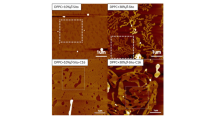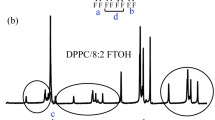Abstract
The hypothesis that the efficacy of hydrophobic antioxidants in animal models of atherogenesis may, in part, be related to physical effects on cholesteryl esters in cells was probed with analogs and metabolites of probucol. The interactions of an effectivebis-thiomethane analog (MDL 29,311) and selected metabolites of probucol with cholesteryl oleate were examined by differential scanning calorimetry and polarized light microscopy. Like probucol, MDL 29,311 and the bisphenol metabolite decrease the liquid-crystalline phase transition enthalpy of cholesteryl oleate with increasing concentrations. At 20 mol%, no transition is detectable. By contrast, the spiroquinone metabolite of probucol and the diphenoquinone metabolite common to both molecules have minimal effects on the liquid-crystalline transitions of cholesteryl oleate. At 20 mol%, neither compound has as great an effect as 1 mol% MDL 29,311. Consistent with their effects on dry cholesteryl oleate, MDL 29,311 and the bisphenol metabolite convert lipid inclusions in cells supplemented with cholesterol to an isotropic physical state similar to that observed with probucol. The number of anisotropic inclusions in the cells decreases with increasing concentration in the medium in the range of 50 to 250 μg/mL. In cells fed with the spiroquinone or diphenoquinone metabolites, the lipid inclusions are liquid-crystalline and resemble those observed with cholesterol-fed controls. These data are interpreted in terms of a model in which hydrophobic antioxidants closely related to probucol disrupt the packing of cellular cholesteryl esters.
Similar content being viewed by others
Abbreviations
- DSC:
-
differential scanning calorimetry
- HPLC:
-
high-performance liquid chromatography
- LDL:
-
low density lipoproteins
- MEM:
-
minimum essential medium
References
Small, D.M., and Shipley, G.G. (1974)Science 185, 222–229.
Steinberg, D. (1989)New Engl. J. Med. 320, 915–924.
McLean, L.R., and Hagaman, K.A. (1988)Biochim. Biophys. Acta 959, 201–205.
McLean, L.R., Thomas, C.E., Weintraub, D., and Hagaman, K.A. (1992)J. Biol. Chem. 267, 12291–12298.
McLean, L.R., and Hagaman, K.A. (1989)Free Radic. Biol. Med. 12, 113–119.
Glick, J.M., Adelman, S.J., Phillips, M.C., and Rothblat, G.H. (1983)J. Biol. Chem. 258, 13425–13430.
Mao, S.J.T., Yates, M.T., Parker, R.A., Chi, E.M., and Jackson, R.L. (1991)Arteriosclerosis and Thombosis 11, 1266–1275.
Coutant, J., Bargar, E.M., and Barbuch, R. (1981) inRecent Developments in Mass Spectrometry in Biochemistry, Medicine and Environmental Research (Frigerio, A., ed.) pp. 35–38, Elsevier, Amsterdam.
Alviram, M., Dankner, G., Cogan, U., Hochgraf, E., and Brook, J.G. (1992)Metabolism 41, 229–235.
Small, D.M. (1988)Arteriosclerosis 8, 103–129.
Author information
Authors and Affiliations
About this article
Cite this article
McLean, L.R., Brake, N. & Hagaman, K.A. Interactions of MDL 29,311 and probucol metabolites with cholesteryl esters. Lipids 29, 819–823 (1994). https://doi.org/10.1007/BF02536248
Received:
Revised:
Accepted:
Published:
Issue Date:
DOI: https://doi.org/10.1007/BF02536248




